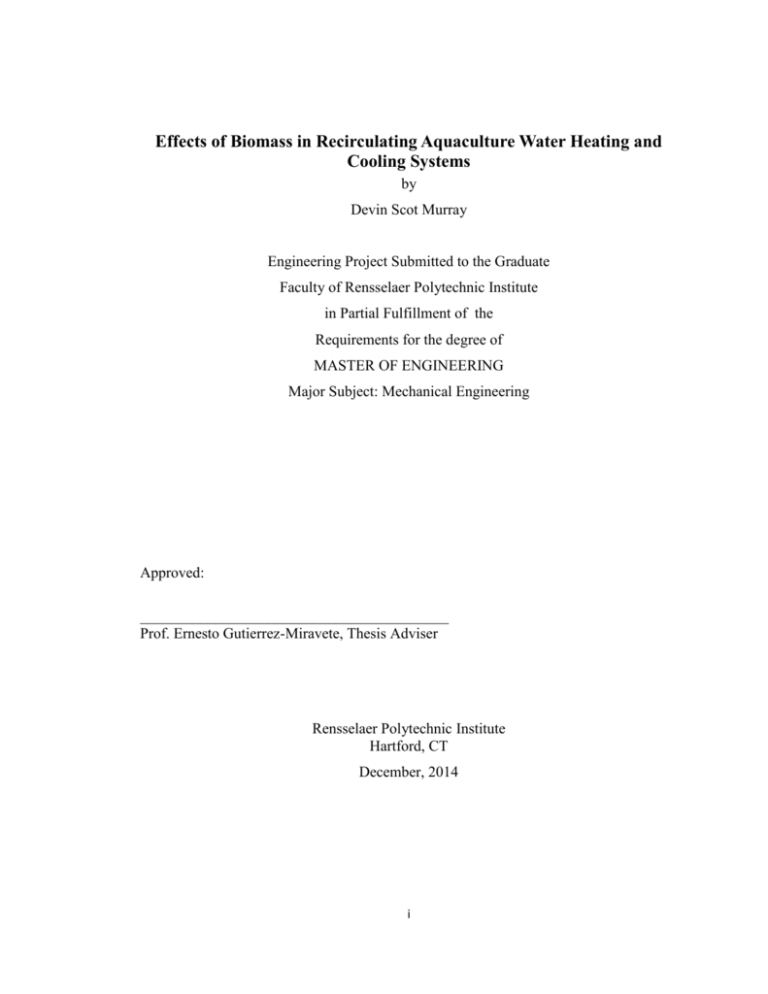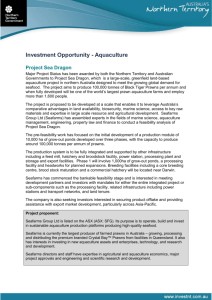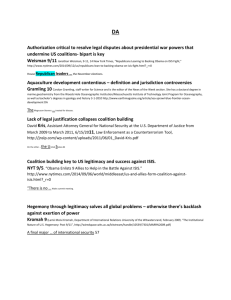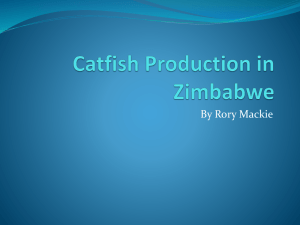
Effects of Biomass in Recirculating Aquaculture Water Heating and
Cooling Systems
by
Devin Scot Murray
Engineering Project Submitted to the Graduate
Faculty of Rensselaer Polytechnic Institute
in Partial Fulfillment of the
Requirements for the degree of
MASTER OF ENGINEERING
Major Subject: Mechanical Engineering
Approved:
_________________________________________
Prof. Ernesto Gutierrez-Miravete, Thesis Adviser
Rensselaer Polytechnic Institute
Hartford, CT
December, 2014
i
© Copyright 2014
by
Devin Scot Murray
All Rights Reserved
ii
CONTENTS
Effects of Biomass in Recirculating Aquaculture Water Heating and Cooling Systems ... i
LIST OF TABLES ............................................................................................................ iv
LIST OF FIGURES ........................................................................................................... v
ACKNOWLEDGMENT .................................................................................................. vi
ABSTRACT .................................................................................................................... vii
1. Introduction.................................................................................................................. 1
1.1
State of the Aquaculture Industry ...................................................................... 1
1.2
Types of Aquaculture ......................................................................................... 2
2. Theory .......................................................................................................................... 5
2.1
Theoretical System ............................................................................................. 5
2.2
Methods of Heat Transfer .................................Error! Bookmark not defined.
3. Method ......................................................................................................................... 7
3.1
3.2
Analytical Analysis ............................................................................................ 7
3.1.1
Definition of System Parameters ........................................................... 9
3.1.2
Conductive Heat Transfer .................................................................... 10
3.1.3
Convective Heat Transfer .................................................................... 10
3.1.4
Radiation Heat Transfer ....................................................................... 10
Computational Analysis ................................................................................... 10
4. Results........................................................................................................................ 11
5. Discussion and Conclusion ........................................................................................ 12
6. References.................................................................................................................. 13
iii
LIST OF TABLES
Table 1: Thermal Properties of Seafood [2] ...................................................................... 5
Table 2: System Parameters............................................................................................... 9
Table 3: Concentration of Tilapia in Raceway ................................................................ 10
iv
LIST OF FIGURES
Figure 1: Aquaculture Production of Tilapia in Millions of Tons [3] ............................... 2
Figure 2: Raceway Style Tank for Recirculating Aquaculture System ............................. 4
Figure 3: Density of Fish in Raceway Style Tank ............................................................. 4
Figure 4: Raceway Dimensions ......................................................................................... 6
Figure 5: Heat Transfer Mechanisms ................................................................................ 7
v
ACKNOWLEDGMENT
I would like to thank my friends Jared Feist and Christopher Stubbs for accompanying
me on the pursuit of my graduate degree in engineering as well as my family for their
continuous encouragement. I would like to extend thanks to my wonderful girlfriend for
her unwavering support. A special debt of gratitude is also due to Dr. Ernesto GutierrezMiravete for his understanding and guidance throughout the completion of this project.
vi
ABSTRACT
High capacity water heating and cooling mechanisms are typically employed in large
scale recirculating aquaculture systems, specifically in regions where the product species
may be subject to sub-optimal growth rates at the extremes of ambient temperature. To
optimize the heating and cooling loads required to keep water temperatures in a desired
range, an analytical model of a recirculating raceway is constructed and analyzed to
account for the inclusion of the product species biomass. The aquaculture system studied
accounts for conduction, forced and free convection, as well as radiative heat transfer
mechanisms between the raceway and the ambient surroundings. Several different
concentrations of biomass are analyzed to provide bounding assumptions to the extent to
which biomass may affect water heating and cooling loads. An overall efficiency is
calculated for each system studied which is based on the heating load required to
maintain
the
temperature
of
the
vii
control
body
of
fresh
water.
1. Introduction
1.1 State of the Aquaculture Industry
Aquaculture, or fish farming, has been practiced by mankind in its various forms for
thousands of years [1]. Similar to terrestrial farming, aquaculture implies some sort of
intervention in the rearing process of the farmed animal such as regular stocking,
breeding, feeding, and protection from predators, to enhance production. In the United
States, the emergence of aquaculture can be traced back to the mid-19th century;
however it was not until the 1960s that rapid expansion in both production and variety of
species farmed took hold [2]. In the ensuing years, per capita consumption of protein
derived from some type of aquatic life form has continued to increase reflecting similar
rates in the worldwide consumption of fish.
To meet this ever increasing demand for aquatic sources of food, producers have begun
to increasingly turn towards aquaculture. Traditional fishing in the world’s oceans and
other large bodies of water is increasingly seen as a resource that has been tapped to its
maximum sustainable limit. This is due to overfishing, pollution and habitat destruction
which have led to significant loss in fish populations and natural diversity [1].
Aquaculture provides a sustainable and controllable means of producing fish to meet the
demands of an ever growing population whose diet is increasingly consisting of more
and more aquatic proteins.
As stated above, current aquaculture practices began in the 1960s in which significant
biological and engineering expertise began to enter the field to optimize production. At
its heart, aquaculture is inherently more energy effective than farming of land based
animals. First, fish are ectotherms (cold blooded) and do not expend energy maintaining
body heat. Secondly, fish are neutrally buoyant in their environment and therefore do not
have to expend energy to support their bodies. Lastly, fish exist in a three dimensional
environment which greatly increases final yield on a per acre basis [2]. For these
reasons, the feed conversion ratio (FCR) of fish, which is the ratio of an animal’s
efficiency in converting feed mass into a usable output, is much greater than that of
1
traditionally farmed animals like cattle and pigs, and similar to that of poultry. This
allows aquatic farmers to expend more energy in maintaining the optimum environment
for their stock animal and remain competitive in the open market. Figure 1 below
illustrates the growth of the aquaculture industry with respect to tilapia, which is one of
the most commonly farmed species of fish.
Figure 1: Aquaculture Production of Tilapia in Millions of Tons [3]
In the creation of the artificial habitats for the product animal, both biological sciences
and mechanical engineering practices come into play. Chemically the water must be free
of toxins, pH balanced, and most importantly properly oxygenated to ensure the survival
of the product. Mechanically the temperature and flow of the water must be properly
controlled. The mechanical aspect of controlling the water temperature for tilapia
production will be further explored in later sections of this report.
1.2 Types of Aquaculture
Modern aquaculture facilities for tilapia generally fall into one of four categories [4]. In
each category, the most important aspect of the water management system is to ensure
clean properly oxygenated water is provided to the product animal to ensure survival. Of
2
secondary, but very high importance is the control of water temperature. Water must be
controlled in the proper band of allowable temperatures to ensure the following: survival
of the product animal, rapid growth, and spawning. As previously noted, all common
commercially grown aquaculture products are ectotherms. Therefore, these animals must
rely on their environment to control body temperature, with heat transfer taking place
through gills and the body walls. The proper temperature encourages a high metabolic
rate in the product animal leading to fast and efficient growth. Specific water
temperatures are also required to allow animals to spawn.
The most common and least labor intensive is a pond water production system. Tilapias
are freshwater fish and therfore may be raised in inland ponds fed by rainwater, streams
and other larger lakes. These ponds may be naturally occurring or man-made but must
ultimately be large enough to induce a naturally occurring ecosystem in which to sustain
tilapia production.
Another common method of aquaculture production is cage culture, in which cages
made of netting are used to constrain the tilapia. Typically these cages are placed in
much larger bodies of water than those that would be used in a pond water production
system.
Flow through raceway production systems are used in areas where an abundance of fresh
water flow is available, such as near large rivers of springs. These set ups allow
continuous water flow through an open trough which contains provisions to constrain the
tilapia. Depending on the available rate of water volume flowing through the raceway,
the system may need to be mechanically supplemented to provide proper aeration for the
density of tilapia contained in the system.
The final category of aquaculture system, and the subject of this study, is a recirculating
system. These systems are used where water is not available in significant volume to use
a flow through model or in regions where the ambient climate is not suitable to permit
year-round production. Recirculating aquaculture systems may utilize earthen ponds,
3
concrete tank or some style of man-made raceway. The most advanced re-circulating
systems may be located in large greenhouses or other climate controlled indoor facilities
to aid in mediation of ambient temperatures. Water treatment in recirculating systems
must include mechanical aeration to add dissolved oxygen, mechanical filtration to
remove large particulate, biological filters to enhance nitrification and mechanical
heating and cooling capacity to control water temperature [4]. Figure 2 below shows
raceway style tanks used in a recirculating aquaculture facility while Figure 3 shows the
high density of fish
Figure 2: Raceway Style Tank for Recirculating Aquaculture System
Figure 3: Density of Fish in Raceway Style Tank
4
2. Theory
This project will explore the postulate that biomass should be accounted for when
performing heat transfer calculations for recirculating aquaculture water heating and
cooling systems. The basis for this postulate is the difference in energy required to heat
or cool fresh water in comparison to the energy required to heat or cool many commonly
farmed species of fish. Subsequently, the energy losses transferring heat into or out of
the fish and into the water will be explored. The commonly accepted specific heat of
fresh water at 30 °C is 4.18kJ/kg-K [1] while Table 1 below shows the thermal
properties (including specific heat) of several common species of animals that are grown
in aquaculture farms:
Table 1: Thermal Properties of Seafood [2]
Review of the information included in Table 1 shows that the specific heat of all
common species of animals grown in aquaculture farms is less than that of fresh water.
Therefore, the potential for optimization of heating or cooling loads required to maintain
a specific water temperature exists and is dependent upon the percentage of biomass in
the system coupled with the distribution pattern of the biomass.
2.1 Theoretical System
To test the postulate proposed in this report, a control system is proposed which
adequately represents current commercial practices. To accomplish this end, a raceway
style recirculating aquaculture system will be used to simulate a body of fresh water
5
used to grow tilapia. The raceway model used is a rectangular pool in which the length is
many times greater than the width and the depth of water is kept to a minimum. This
design is optimal for indoor recirculating aquaculture facilities as the geometry of the
pool provides a natural river-like flow pattern from one end of the raceway to the other
to aid in ensuring water replacement. The total volume of water that fills the raceway
must be cycled through filter, aeration, and temperature control systems at least once per
day to ensure sufficient water quality to allow for optimal growth conditions of the
aquaculture product. Figure 4 below shows the overall geometry that will be used for
this study:
Figure 4: Raceway Dimensions
The system represents a large section of a raceway pool; however it does not include the
ends of the raceway. This is done to simplify analysis be removing the need to consider
end affects of water discharge and return which would complicate analysis but not
provide added value to the investigation at hand.
6
3. Method
3.1 Analytical Model
This study will use the model proposed in Section 2 to analyze the heat transfer
mechanisms in the recirculating raceway. Figure 5 below shows how the heat transfer
mechanisms are applied in the system:
Figure 5: Heat Transfer Mechanisms
7
Figure 6: Heat Transfer Diagram – Without Biomass
8
Figure 7: Heat Transfer Diagram – With Biomass
3.1.1
Definition of System Parameters
Table 2: System Parameters
Variable
Tw-in
T∞
Tf
Tw-out
Tw
ρw
kw
kc
Cpw
Description
Water inlet temperature
Ambient air temperature
Fish temperature
Water outlet temperature
Log mean temperature
Density of water at 30° C
Thermal conductivity of water
Thermal conductivity of cement
Specific heat of water
9
Value
305.15
283.15
TBD
996.025
0.616
0.720
4.181
Unit
K
K
K
K
K
kg / m3
W/mK
W/mK
kJ / kg K
w
tw
Aw
8264 x 10-7
.010
100
Viscosity of water
Thickness of wall
Area of wall
Ns/m
m
m2
Table 3: Concentration of Tilapia in Raceway
Case 1 Case 2 Case 3 Case 4 Case 5
30%
40%
50%
60%
70%
𝑹𝒆 =
𝑫𝑯 =
3.1.2
Assumptions
3.1.3
Conductive Heat Transfer
𝑫𝑯 𝝆 𝒖𝒘
𝟒𝒂𝒃
Convective Heat Transfer
3.1.5
Radiation Heat Transfer
Eq. 2
𝟐𝒂+𝒃
𝒒𝒄𝒐𝒏𝒅 = −𝒌𝒄 × 𝟐 𝑨𝒘
3.1.4
Eq. 1
𝝁
𝑻∞ −𝑻𝒘
𝒕𝒘
Eq. 3
3.2 Computational Analysis
Computational analysis of the theoretical system is used to investigate the impact of fish
distribution in the raceway on the overall specific heat capacity of the system
10
4. Results
11
5. Discussion and Conclusion
12
6. References
[1]
Kathryn White, Brendan O’Neil, and Zdravka Tzankova, At a Crossroads: Will
Aquaculture Fulfill the Promise of the Blue Revolution? Copyright © 2004
[2]
LaDon Swann, A Basic Overview of Aquaculture History, Water Quality, Types
of Aquaculture, Production Methods, August 1992
[3]
Food and Agriculture Organization of the United Nations, faostat.fao.org,
Copyright © 2013
[4]
Claude E. Boyd, Farm-Level Issues in Aquaculture Certification: Tilapia
[X]
Transport Phenomena in Multiphase Systems; A. Faghri and Y. Zhang;
Copyright © 2006; Elsevier Inc. – Appendix B, Page 980, Table B.48
[X]
Measurement of Thermal Properties of Seafood; Radharkishnan, Sudhahrini;
Thesis Virginia Polytechnic Institute and State University June 26, 1997
[X]
Fundamentals of Heat and Mass Transfer; F. Incropera, D. Dewitt, T. Bergman,
A. Lavine; Copyright © 2007; John Wiley & Sons Inc. - XXXXXXX
13










